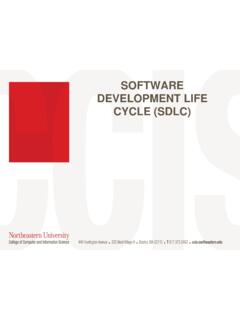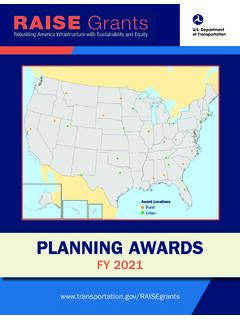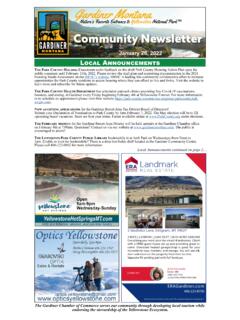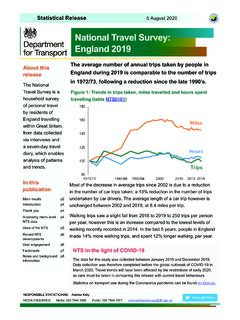Transcription of Networked Transport of RTCM via Internet Protocol (Ntrip)
1 Networked Transport of RTCM via Internet Protocol (Ntrip) Version The material provided here is not the official RTCM documentation! This can only be ordered from ii TABLE OF CONTENTS 1 Introduction .. 1-1 2 SYSTEM CONCEPT .. 2-1 3 System Elements ..3-1 General ..3-1 NtripSource .. 3-1 NtripServer .. 3-1 NtripCaster .. 3-1 NtripClient ..3-2 4 Server Communication .. 4-1 5 Client 5-1 General ..5-1 Basic Authentication Scheme .. 5-1 Digest Authentication Scheme.
2 5-2 NMEA Request 5-2 6 Source-Table .. 6-1 7 7-1 APPENDIX A Example Source-Table ..A-1 APPENDIX B Format Specifications ..B-1 APPENDIX C Example Client Source Code ..C-1 iii PREFACE Networked Transport of RTCM via Internet Protocol (Ntrip) is an application-level Protocol that supports streaming Global Navigation Satellite System (GNSS) data over the Internet . Ntrip is a generic, stateless Protocol based on the Hypertext Transfer Protocol The HTTP objects are extended to GNSS data streams. Ntrip is designed to disseminate differential correction data or other kinds of GNSS streaming data to stationary or mobile users over the Internet , allowing simultaneous PC, Laptop, PDA, or receiver connections to a broadcasting host.
3 Ntrip supports wireless Internet access through Mobile IP Networks like GSM, GPRS, EDGE, or UMTS. Ntrip consists of three system software components: NtripClients, NtripServers and NtripCasters. The NtripCaster is the actual HTTP server program, while NtripClient and NtripServer act as HTTP clients. Ntrip is meant to be an open non-proprietary Protocol . Major characteristics of Ntrip s dissemination technique are the following: It is based on the popular HTTP streaming standard; it is comparatively easy to implement when limited client and server platform resources are available. Its application is not limited to one particular plain or coded stream content; it has the ability to distribute any kind of GNSS data.
4 It has the potential to support mass usage; it can disseminate hundreds of streams simultaneously for up to a thousand users when applying modified Internet Radio broadcasting software. Regarding security needs, stream providers and users are not necessarily in direct contact, and streams are usually not blocked by firewalls or proxy servers protecting Local Area Networks. It enables streaming over any mobile IP network because it uses TCP/IP. This documentation describes Ntrip Version Further Ntrip versions may be issued as the need arises. ` 1-1 1 INTRODUCTION Since the deliberate degradation of GPS signals, called Selective Availability, was turned off, stand-alone GPS receivers typically experience position errors of 10-15 meters, and these errors follow a random walk pattern.
5 While this accuracy is adequate for a wide variety of applications, there are other applications where meter-level, or even centimeter-level, accuracy is desired. For such high-accuracy applications, a Differential Global Navigation Satellite System (DGNSS) can be employed successfully. A DGNSS improves the accuracy of position, velocity, and time by providing measurements or correction data from one or more reference stations to mobile receivers. The position of each reference station is accurately known, so its measurements act as a calibration for other nearby receivers, because the major error sources are common: satellite ephemeris and clock, tropospheric and ionospheric delay.
6 The DGNSS accuracy degrades as the distance between user and reference receivers increases, so for some applications, information from multiple reference stations is desirable. A DGNSS can utilize differential corrections for any GNSS (GPS, GLONASS, Galileo) to achieve meter-level accuracy, or it can use Real Time Kinematic (RTK) information to achieve decimeter or centimeter accuracy. The DGNSS data needs to be refreshed every few seconds to keep up with atmospheric changes. RTCM-104 DGNSS standards are used worldwide. Many popular GNSS receivers accept RTCM-104 differential correction messages, and many special-purpose RTK receivers use the RTK messages. The RTCM SC-104 standards define messages that contain reference station and system data.
7 These messages are typically broadcast over a transmission link and received by mobile users, which then apply the information contained in the messages to achieve high-accuracy operation. The data can be transmitted over any number of communication channels, , via radio transmission (LF, MF, HF, UHF), or via a mobile communication network, using different communication protocols. The introduction and deployment of wireless Internet capability has opened up the potential of disseminating these messages over the Internet . This document defines a standard for an HTTP-based Protocol for the dissemination of DGNSS data (or other kinds of GNSS streaming data) to stationary or mobile receivers over the Internet .
8 It enables simultaneous PC, Laptop, PDA, or receiver connections to a broadcasting host, via IP Networks such as GSM, GPRS, EDGE, or UMTS. The Protocol development is the result of a feasibility study on real-time streaming of differential GPS corrections as described in [1]. Because the primary application will be the dissemination of RTCM SC-104 messages, the system as a whole presents a Transport Protocol that will be referred to herein as the Ntrip Protocol ( Networked Transport of RTCM via Internet Protocol ). The basic data streaming is accomplished by TCP/IP Protocol stack. Several demonstrations based on a plain Serial-to-TCP conversion of streaming data on the reference-side (server) and TCP-to-Serial re-conversion on the rover-side (client) have shown the suitability of the TCP/IP Protocol for streaming data to mobile IP clients [2].
9 ` 2-1 2 SYSTEM CONCEPT The Hypertext Transfer Protocol (HTTP) is designed as an application-level Protocol for distributed collaborative hypermedia information systems, but it can also be used for linear streaming media. HTTP is primarily used for bulk traffic, where each object has a clearly defined beginning and end.
10 Although widely used for IP streaming applications, which include the RTCM application, it is not designed for such uses. The basic unit of HTTP communication, consisting of a structured sequence of octets matching the syntax, is defined in the Protocol and transmitted via a TCP/IP connection. Client and server must understand HTTP request messages, and must answer with adequate HTTP respond messages. Ntrip, which uses HTTP, is implemented in three programs: NtripClient, NtripServer and NtripCaster, where the NtripCaster is the real HTTP (splitter-) server. NtripClient and NtripServer act as HTTP client programs. In its message format and status code, the NtripClient-NtripCaster communication is based on HTTP communication [3], where Ntrip uses only non-persistent connections.






